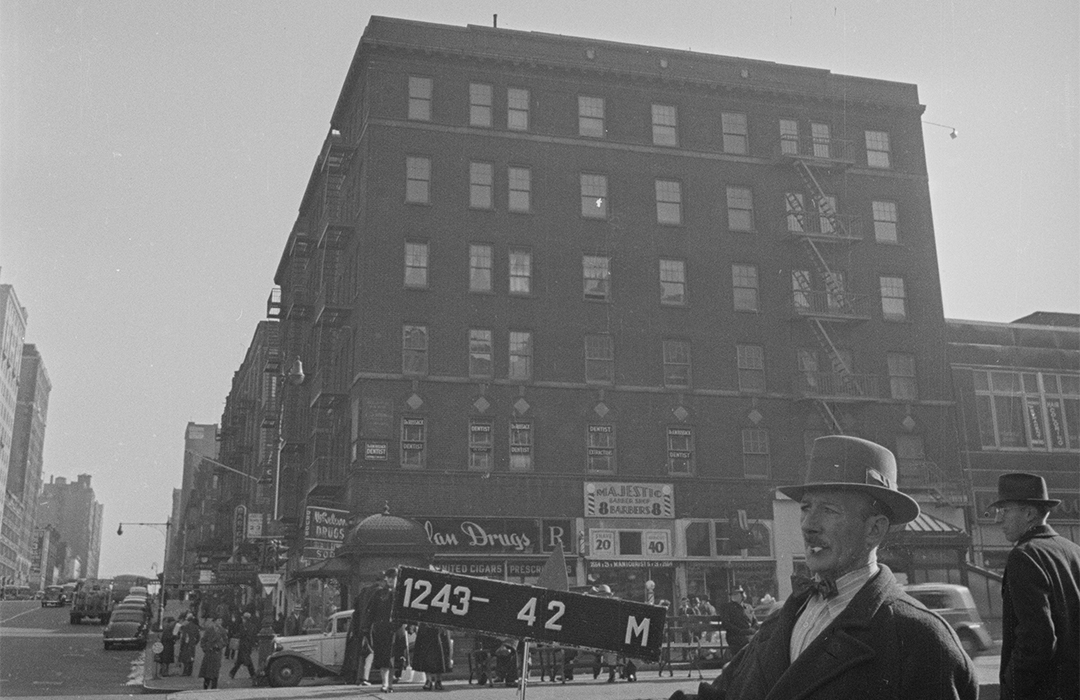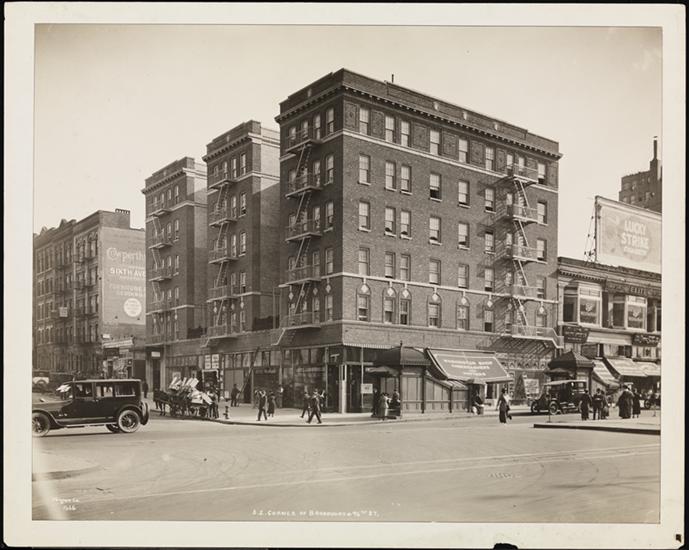
2552-2558 Broadway
by Tom Miller
With the death of his father, John Jacob Astor IV who died on the RMS Titanic in 1912, 21-year-old William Vincent Astor became one of the wealthiest men in the world. When America entered World War I, he enlisted for active duty and served overseas. Following the war, he returned to the United States in April 1919 and was discharged the following month.
He immediately returned to running the immense Astor real estate holdings. Among the first items to which he turned his attention was the apartment-and-store building at the southeast corner of Broadway and 96th Street designed by Schwartz & Gross, which was already under construction. Three months after his army discharge, on August 16, 1919, the Real Estate Record & Guide reported that William V. Astor had leased the corner store in the still uncompleted building to the United Cigar Stores Co. of America.
The structure was completed in 1920. The architects’ six-story structure was faced in brown Flemish-bond brick. While overall Renaissance Revival in style, it borrowed elements of the quickly fading Arts & Crafts movement, like the diamond insets over the second-floor windows. The structure faced West 96th Street, it’s mass divided by two deep light courts which made the building appear at first glance to be three.
The residents of the new building were all well-to-do, but not all of them acquired their money by the most respectable means. Among the original tenants was Abraham Levy, described by the New York Herald as “head of the Hyland political organization” and the operator of “a photographic studio and theatre ticket agency.” He also went by the alias Albert MacKenzie. Levy not only had a second name unknown to his neighbors, but he had another business, as well–that one located at 345 East 20th Street.
The New York Times reported on the “explosion of a 15-gallon still” there, saying it blew out the windows, wrecked the room in which it occurred, and “caused excitement in that neighborhood.”
A substantial accident occurred in the 20th Street building on October 29, 1921—one that would put Levy out of business and behind bars. The New York Times reported on the “explosion of a 15-gallon still” there, saying it blew out the windows, wrecked the room in which it occurred, and “caused excitement in that neighborhood.” The article said, “The force of the explosion was so great that thousands of persons thought a bomb had been set off.” Abraham Levy was arrested. According to United States Commissioner Hitchcock, he was “alleged to be the leader of a ‘bootleg’ ring handling many thousands of cases of whisky in recent months.”
Resident Florence Levenson left her apartment on the night of November 11, 1926. While she was out, a burglar helped himself to her jewelry and expensive clothing. As it turned out, however, the police would discover the theft even before Florence did.
Later that night the attention of Detectives Edward Schnaible and Patrick MacDonald were drawn to a “well dressed youth, who walked briskly down Broadway and deposited a suitcase…in an areaway at Ninety-sixth street,” as reported by The New York Sun. The detectives retrieved the suitcase, then followed the 16-year-old. Apparently aware that he was being trailed, the teen disappeared into an apartment house on West 97th Street. The detectives followed and “found the youth hiding in the dumbwaiter shaft.”
Timothy Curran admitted to burglarizing Florence Levenson’s apartment. In the suitcase and on his person were jewelry and clothing valued at the equivalent of more than $30,500 in 2023. He had been released from the Catholic Protectory just six months earlier. Apparently wanting to make a clean break of things, he also admitted to burglarizing an apartment on Riverside Drive a few days earlier, taking thousands of dollars’ worth of jewelry.
Thelma Jordan and Mary Morris shared an apartment in the early 1930s. Both were prostitutes working for the Charles “Lucky” Luciano crime organization. When Thelma was approached by Special Prosecutor Thomas E. Dewey in 1936 to testify in a case against Luciano, she agreed. In its October 1937 issue, The Atlantic said in part, “The courtroom sat up straighter when small, plump Thelma Jordan, a hotel prostitute, proved to be the daughter of a state official in the Middle West.” Thelma spilled more incriminating beans than the prosecution could have hoped for. And much more than the mob could abide.
In his 2010 book Lucky Luciano—the Rise and Fall of a Mob Boss, William Donati recalls Thelma’s return to 214 West 96th Street. As she packed her clothing in preparation to hide out, Mary Morris warned her that she would be kidnapped by gang member Willie Spiller. Thelma sought police protection, saying, “They were going to snatch me and take me out and torture me and kill me because I testified.”
A bizarre tragedy occurred in the building in January 1937. Living here in a third-floor apartment was the elderly couple Peter Charles Geyer Sr., a retired military officer, and his wife Eliza. Their son, Peter Jr. joined the Marine Corps in 1916 and was promoted to major on July 1, 1930. The well-educated marine was described by a commanding officer as “one of the best linguists in the corps.” He spoke four languages fluently: French, German, Spanish, and Flemish.
Major Geyer had recently been transferred from San Diego to Baltimore in the recruiting unit. He traveled to New York to see his parents for Christmas but, for some reason, returned to Baltimore without visiting them. Once back, he received a telegram that his father was seriously ill and hospitalized with pneumonia. He immediately returned to New York City.
On the morning of January 2, 1937, a family friend and the godmother of Major Geyer, Mary Gelis, stopped by. No one answered the bell, and there was a bottle of milk sitting at the door. Concerned, she informed the building superintendent John Nolan. The New York Times reported, “It was after 2 before Nolan and Lionel Mapp, elevator operator, were able to get in by way of a ladder stretched from a fire-escape landing.” They discovered Major Geyer’s body on the living room floor. He had plunged a kitchen knife into his abdomen. Then, in the kitchen, they found 80-year-old Eliza Geyer, stabbed to death with the same knife. No reason for the murder-suicide could be gleaned. The newspaper added, “At the hospital, the condition of the older Geyer was reported as very grave. He was in an oxygen tent last night.”
He had plunged a kitchen knife into his abdomen.
Another tenant brought unwanted attention to the building that year. Chester Miller was a building contractor. He was working on a construction project that year in Ardsley, New York. It may have been the ongoing Depression that forced the 38-year-old to take desperate actions. On July 26, 1937, The Daily News reported on an “eight-state alarm for Chester Miller.” Over the past few weeks he had passed multiple bad checks—some of them equal to nearly $19,000 in today’s money.
A search had already been ongoing for Miller for a week. At one point a plainclothes officer was positioned outside the apartment building where his car was parked. On July 25, the officer left to report to his lieutenant, and when he returned, according to The Daily News, “the car was gone and Miller and his wife were reported to have left for ‘someplace in Long Island.’” It is unclear when (or if) Miller was apprehended.
The Broadway space that had been a United Cigar store when the building opened was home to a Bickford’s Restaurant in 1946. It was full of breakfast patrons at 9:00 on October 29 that year when 23-year-old Harold Jacobs, who lived on Riverside Drive, came driving east on 96th Street towards Broadway. Suddenly the young man slumped over onto the steering wheel, causing the horn to blare. A pedestrian called out to an elderly man sitting on the bench in the park-like median on Broadway. The Sun wrote, “The man ran into the path of the car and was killed.” Jacob’s automobile struck an iron post and continued onto the sidewalk and into the Bickford’s Restaurant window. The article said, “Although some 100 persons were eating inside, none was injured by the shattered glass.” Jacobs, who was diabetic, had taken an accidental overdose of insulin.
A renovation completed in 1974 resulted in 10 apartments per floor. Above the ground level, the building is little changed since it’s opening over a century ago.
Tom Miller is a social historian and blogger at daytoninmanhattan.blogspot.com
BUILDING DATABASE
Keep Exploring
Be a part of history!
Think Local First to support the businesses currently at 2552-2558 Broadway aka 214 West 96th Street:



